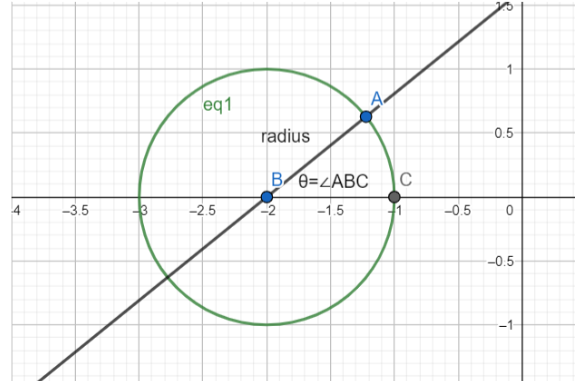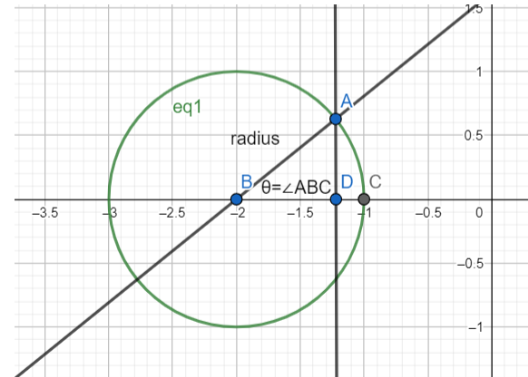Question
Question: Find the parametric form of the equation of the circle \({{x}^{2}}+{{y}^{2}}+px+py=0\)....
Find the parametric form of the equation of the circle x2+y2+px+py=0.
Solution
Hint: To convert from the general form to the parametric form of the equation of a circle, all we have to do is find the centre of the circle and the radius.
x=rcost+x0y=rsint+y0 is the parametric equation of a circle whose centre is (x0,y0), and radius is r.
Parametric form of a circle is a way to express the general formula of any point lying on that circle in terms of the circle’s radius, centre’s coordinates, and an angle θ.

In the above figure, let’s consider A to be the point that we want to express as a general point lying on the circle.
We know that, length of AB= radius of the circle
And, θ=∠ABC.
Let the coordinates of point A=(X,Y)
The equation of the circle drawn here is : x2+y2+4x+3=0. ……………...(1)
From here, if we compare it with the general equation of a circle which is :
x2+y2+2gx+2fy+c=0, we get :
2gx=4x⇒2g=4⇒g=2
And, 2fy=0⇒2f=0⇒f=0
Since, we know that, the centre of the circle having the general equation = (−g,−f), and radius = g2+f2−c, we can compare again and find that :
Centre of the circle (1) drawn here, C=(−g,−f)=(−2,0)
And its radius, r=g2+f2−c=22−3=1
Hence, for the point (X,Y) or A, we can say that :
(X−(−2))2+(Y−0)2=r=1
Or, we can drop a perpendicular from A to the line BC, and form a right angled triangle. Let’s call the point where the perpendicular is dropped, D.

From the triangle ABD, we can conclude that, since it’s a right angled triangle,
cosθ=ABBD , and sinθ=ABAD
⇒BD=ABcosθ⇒BD=rcosθ⇒(Y−0)=rcosθ⇒Y=rcosθ and ⇒AD=ABsinθ⇒AD=rsinθ⇒(X−(−2))=rsinθ⇒X+2=rsinθ⇒X=rsinθ−2
We have substituted the length of AB as the radius of the circle, as shown in the diagram, and later substituted for the lengths of BD and AD by finding the difference of only the x and y coordinates at one time.
Hence, we can now write that the general point A=(X,Y)=(rsinθ−2,rcosθ).
This form of expressing a point in the parametric form is called so since the parameters here are the angle the point makes with the x axis and the radius of the circle.
Applying this knowledge in the question given to us, we’ll proceed stepwise.
First, let’s compare the equation S1=x2+y2+px+py=0 with the general equation x2+y2+2gx+2fy+c=0. Doing so, we get :
2gx=px⇒2g=p⇒g=2p and 2fy=py⇒2f=p⇒f=2p
The centre of circle S1,C1=(−g,−f)=(−2p,−2p)
And the radius, r1=g2+f2−c=4p2+4p2=2p2=2p
To express the general point on this circle in terms of parameters the radius and the angle made with the x axis, we assume it makes an angle t, since this angle varies according to the point’s position on the circle, but the radius remains fixed because a circle is a collection of points that have a fixed distance from a particular point.
Hence, the parametric equation of the circle is :
x=r1cost+gy=r1sint+f
Where, (x,y) are the coordinates of any general point on the circle.
Substituting for r1,g,f, we get :
x=2pcost−2py=2psint−2p
Hence, this the parametric equation of the circle given to us.
So, answer is the parametric equation of the circle is : x=2pcost−2py=2psint−2p
Note: You should remember the general method of converting a general equation of a circle into the parametric equation form. The parametric equation of a circle can be directly written as : x=rcost+x0y=rsint+y0 where (x0,y0) is the centre of the circle and r= the radius of the circle. This way, you can directly convert just by finding the centre and the radius of the given circle.
